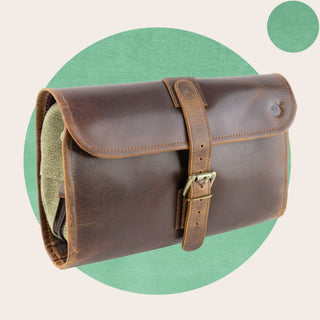Looking to get the low down on one of the most popular and enduring varieties of leather on the market today? What is Nappa leather? Where did it come from and what was the world like before it became a mainstay of the leather market?
All this and more today as we explore the history of this leather enigma as well as its production.
So, What is It?
Well, you might already have surmised that it is a way to describe a different kind of leather. But is it even that different from full-grain leather?
Well, genuine Nappa leather is believed to be an incredibly soft leather - as though it has been met with leather conditioner already - while also being smooth and strong.
Sometimes referred to as Napa leather, this leather does not actually have an ultimately clear definition and can, therefore, range in thickness, finish, grain, and coloring. This is especially pronounced by the fact that the animal from whom the leather comes is not predetermined, meaning that high-quality leather via Nappa is not made with just one kind of animal hide.
This may come as a shock to many who are used to their natural grain leather coming from one animal species, as in cowhide leather which comes from cow skin, or Berkshire from pig skin.
One of the main pulls with, say, a Nappa leather interior is the sheer number of options there are for customization. This is because Nappa leather seats - much like vegetable-tanned leather - are dyed in a multitude of different hues. Thus, this leather will ultimately be desirable for those with a keen eye for customization and personalization while never forfeiting the use of top-grain leather.
Seeing as it is almost always a high-quality leather, you can rely on waterproof Napa leather to keep you dry if indeed you are using it as a garment. Heck, even unfinished Nappa leather would do the job!

Some History
This story begins with native American tribes who roamed and occupied what is now called America long before any settlers arrived from Europe.
Common knowledge says that during these times there were two tribes. It's doubtful that this is the case and that, in fact, there were many, but these two were likely the largest and most significant in terms of power and numbers. These central two tribes were called the Wappo and the Wapin.
When the European settlers arrived and tried to pronounce local words, Napa is the word they came up with. This word eventually inspired the name of a city in California, founded in 1847. California was not a state until 1849, however, and prior to this statehood, the city was allegedly referred to as Nappa.
Though the former spelling with only 1 P has remained for the city, it is both spellings that are used interchangeably in today's leather market. Sadly, what came next was ruthless and is still not talked about in the manner it deserves - mass genocide of indigenous peoples throughout the western world.
Indeed, though it was their mistranslated word that eventually became the name for this kind of leather, they were not the ones who invented Napa leather. In fact, they were neither the ones who reaped any such reward from the invention and manufacture of this new variety of leather.
So, Who Invented Napa Leather?
That title goes to Emanuel Manasse, a German emigree born in 1842 who ended up moving to the United States in 1864. He first moved to New Jersey on the east coast before eventually making his way to Napa, California in 1871.
Being the son of a leather tanner in Germany, it only made sense that he would continue his father's craft in the Newfoundland of America. Thus, he worked as a leather tanner himself in New Jersey, working for the Sawyer Tanning Company established in 1869.
He continued to work as a leather tanner after moving to the west coast, developing what we now know as Napa leather in 1875. He deemed it soft, smooth, and well suited for the art of glove making, something Manasse was very passionate about. Though he did not name it Napa, it made sense that it should be called this seeing as it was developed there.
The soft and flexible leather was always of high quality and soon became popular outside of Napa. Owing to this success, Manasse would later become a partner at the Sawyer Tanning Company in 1880, clearly having earned his stripes.

Afterward, he led a rich and successful life thanks to his invention and contributions to the development of the art of leather tanning. Though also relatively well-known for vinification, Manasse also put Napa on the map for being an esteemed part of the history of leather making. Now, people do not just think of wine when they think of Napa.
How is Napa Leather Made?
So, now we arrive at the big question of how Napa leather is actually made.
There are 3 main steps in the production of any leather from animal skin to leather itself. First, the animal hide is prepared. Second, the leather is tanned. And, third, the leather is left to finish.
The first step of creating Napa leather is no different from the creation of any other full-grain or top-grain leather. Top-grain leather, though, is typically sanded or buffed down to remove any imperfections. The real differences begin in the next step.
In contrast to the production of other leather, the tanning process is a little different when making Napa leather, instead opting for the use of the chromium tanning process. This method is faster than typical tanning methods, using chemicals to break down the animal skin and turn it into leather instead of allowing a natural process to do so over time.
Manufacturers in this trade use chromium or aluminum to tan the leather, using these chemicals to give the leather its distinct softness. This is not all, however, for the use of these chemicals can, paradoxically, lengthen the leather's lifespan considerably.
Similarly, the chemicals used in this process also mean that Napa leather is easier to clean than some other varieties of leather because it is dyed in water-soluble colorants. Thus, it is naturally (or chemically) doused with a water and stain protectant. In this way, it is both easy to dust and far more resistant to spillages than other varieties of leather.
Final Words
So, there you have it! Hopefully, you are now feeling ready and able to go out into the world, safe in the knowledge that you now know precisely what Nappa leather is and what the world was like before it came to be.
FAQs Nappa Leather
IS NAPPA LEATHER GENUINE LEATHER?
Indeed it is and, up until the 2nd stage of the tanning process, is actually prepared the exact same way that any top-grain or full-grain leather is, besides the tanning and sanding involved in ridding the former of its imperfections of course. The difference between Nappa leather and other varieties of leather lies in the tanning process itself. Prior to this, the process is exactly the same, just as it is afterward too. It is by the use of the chromium tanning process that Napa leather received its unique characteristics.
IS NAPPA LEATHER BETTER THAN LEATHER?
Not necessarily, primarily because Nappa leather is leather. There are, however, a number of so-called desirable characteristics that set this variety of leather apart from the rest and which, thus, can give the impression that it is better than other varieties of leather. Nappa leather is, for example, often believed to boast a softer and smoother finish overall. While some other varieties might opt for this kind of quality over strength, Nappa leather is able to offer both softness and strength in one package thanks to its use of the chromium tanning process.
IS NAPPA LEATHER GOOD QUALITY?
Indeed it is. In fact, Nappa leather is more or less the exact same quality as any full-grain leather or top-grain leather. This is because more or less the same quality of animal hide is used to make Nappa leather as other high-quality varieties of leather. Up until the tanning part of the process, the production of Nappa leather is much the same as these other varieties, though it is this tanning process that really sets it apart.
DOES NAPPA LEATHER LAST?
Indeed it does. Much as any other variety of high-quality leather is resistant to the elements, Nappa leather is much the same. In fact, Nappa leather is believed to be even better at resisting these elements, thanks in no small part to the chromium tanning process. Utilizing chemicals in this process, though frowned upon by some leather purists, has definite benefits. These include an objectively softer and smoother finish, increased lifespan, as well as a better resistance to fluids, meaning you are less likely to have any unhappy accidents.



